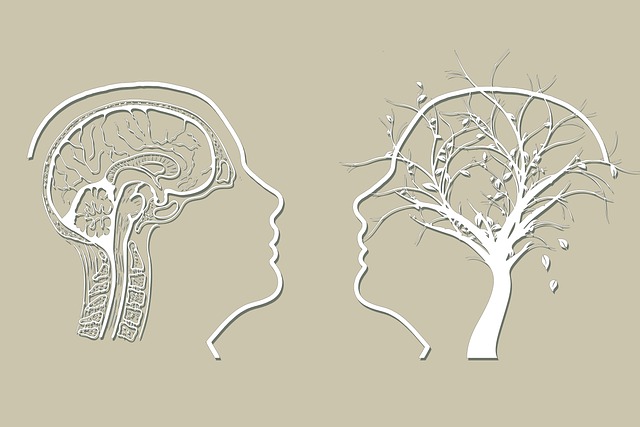Evaluating Greenwood Village Online Therapy's success involves a multi-faceted strategy combining client satisfaction surveys, therapeutic outcome assessments, and engagement tracking. This includes quantitative measures like changes in symptom severity via standardized assessments, alongside qualitative insights from Mental Wellness Journaling Exercise Guidance. The comprehensive approach not only measures individual benefits but also contributes to broader Mental Health Policy Analysis and Advocacy, enhancing services' continuous improvement. Clear goals and measurable objectives, such as enhanced access, improved satisfaction, or reduced anxiety/depression symptoms, guide evaluation and informed adjustments. This holistic view extends beyond individual outcomes to societal impacts, aligning with policy analysis and advocacy efforts, fostering a more supportive mental wellness environment in Greenwood Village and beyond. Researchers employ both quantitative (numerical data, statistical analysis) and qualitative (interviews, focus groups, case studies) methodologies for a comprehensive understanding of the program's effectiveness.
Greenwood Village Online Therapy is transforming mental wellness support through rigorous program evaluation. This comprehensive guide delves into the multifaceted approach used to assess the impact and effectiveness of their online therapy services, focusing on key metrics and client feedback integration. By exploring quantitative and qualitative methods, relevant metrics, and long-term outcome tracking, this article provides valuable insights into Greenwood Village’s commitment to continuous quality enhancement, ensuring sustained mental health support for their clients.
- Assessing Program Impact: Metrics and Measures for Greenwood Village Online Therapy
- – Defining evaluation goals
- – Quantitative vs. qualitative methods
Assessing Program Impact: Metrics and Measures for Greenwood Village Online Therapy

Evaluating the impact of Greenwood Village Online Therapy involves a comprehensive approach to measure its effectiveness in enhancing mental wellness. Metrics such as client satisfaction, therapeutic outcomes, and engagement rates provide insights into the program’s success. Regular surveys and feedback mechanisms allow clients to share their experiences, offering valuable qualitative data. Quantitatively, tracking changes in symptom severity through standardized assessments before and after therapy can demonstrate the program’s tangible impact on mental health conditions.
Moreover, integrating Mental Wellness Journaling Exercise Guidance within the online platform enables researchers to analyze participant-reported improvements over time. This qualitative and quantitative combination offers a holistic view of Greenwood Village Online Therapy’s benefits, addressing not just individual cases but also contributing to the broader Mental Health Policy Analysis and Advocacy efforts, ensuring continuous improvement in mental health services.
– Defining evaluation goals

Evaluating a mental wellness program requires a clear understanding of its goals and objectives. This process begins with defining specific evaluation goals that align with the program’s intended outcomes. For instance, a Greenwood Village Online Therapy initiative might aim to enhance access to mental health services, improve client satisfaction, or reduce symptoms of anxiety and depression among participants. These goals should be measurable and time-bound, allowing for tracking progress and identifying areas for improvement. By setting clear evaluation targets, the program can ensure its effectiveness and make data-driven adjustments to better serve clients, as evidenced by successful mental wellness podcast series production and healthcare provider cultural competency training initiatives.
Additionally, evaluating mental wellness programs should encompass broader societal impacts, reflecting the interconnection with mental health policy analysis and advocacy. This involves assessing how the program contributes to systemic changes, increases awareness, or influences mental health policies and practices. Such an approach not only measures individual success stories but also the program’s potential to create sustainable change on a larger scale, ultimately fostering a more supportive environment for mental wellness in communities, including Greenwood Village and beyond.
– Quantitative vs. qualitative methods

When evaluating mental wellness programs, researchers often employ either quantitative or qualitative methodologies. Quantitative methods involve numerical data and statistical analysis, focusing on measurable outcomes and trends. This approach is valuable for understanding the program’s overall impact on large populations, as it allows for generalizability and the identification of correlations between program participation and improved mental health indicators. For instance, surveys distributed to a significant number of clients in Greenwood Village Online Therapy can provide insights into changes in anxiety levels or depression scores over time.
In contrast, qualitative methods delve deeper into individuals’ experiences and perceptions. Techniques like interviews, focus groups, and case studies capture rich, contextual data that quantitative methods might miss. These approaches are particularly useful for exploring participants’ subjective feelings about the program’s effectiveness, such as improvements in their ability to manage stress through mindfulness meditation or the impact of public awareness campaigns development on their mental wellness journey. Additionally, qualitative research can uncover unique insights into barriers and facilitators related to participating in Stress Management Workshops Organization, providing valuable feedback for refining these programs.
Evaluating mental wellness programs is essential for measuring their effectiveness, and Greenwood Village Online Therapy leads the way with innovative assessment strategies. By combining quantitative data, such as improved symptom scores, with qualitative feedback from participants, the program offers a comprehensive view of its impact. This dual-approach ensures that the success of Greenwood Village Online Therapy goes beyond mere numbers, capturing the nuanced experiences and benefits derived by those seeking mental health support through this digital platform.








